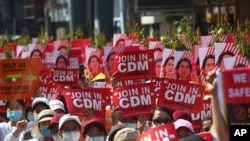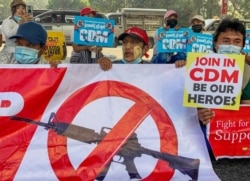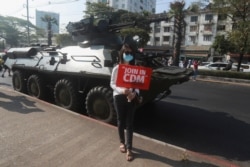Myanmar professionals who are vital to the country’s economy are spearheading the Civil Disobedience Movement (CDM) against the country’s post-coup military regime.
Anti-coup protests in Myanmar, attracting tens of thousands nationwide, have taken to the streets since the February 1 coup against the civilian government led by Aung San Suu Kyi’s National League for Democracy.
Since the coup, the CDM has attracted support from a broad range of professions, led by medical and health care workers. Bankers, lawyers, teachers and engineers across the nation have demanded the military return the elected government to power, refusing to return to work.
The CDM began as an online campaign but has expanded into a wider pro-democracy movement. Medical workers in the CDM, spoke to VOA about the origins of their efforts.
Naypyidaw surgeon Zwe Min Aung told VOA, “At the time, we really disagreed [with] this [the military coup], and we created [a] small group in Mandalay hospital and other hospitals, too. We distributed the statement on February 2 from Facebook and the nationwide CDM began. There is no leader.”
Myay Latt, a Yangon doctor, added, “The CDM movement [is] a collective leadership. We are all the followers and leaders. The military coup surprisingly arises, and our leaders were detained. We use Facebook for access to social media and we use other social media to start the Civil Disobedience Movement.”
Myanmar, also known as Burma, was ruled by the military from 1962 until 2011. In 2015, Suu Kyi and the NLD won the country’s first election since military rule ended.
The military-backed opposition lost heavily to the NLD in elections last November and claimed widespread electoral fraud. The military coup began February 1, removing the elected government. Military commander-in-chief Min Aung Hlaing took power, announcing a “one-year-long state of emergency” and that a future general election would be held.
Since then, widespread protests have taken place across Myanmar, with thousands demanding an end to the coup. Armored vehicles have been deployed on the streets, with authorities opening fire on several occasions. More than 600 people have been arrested, and several deaths have been reported.
Military chief Min Aung Hlaing has publicly told medical professionals to go back to work, but demonstrations have continued, despite the military’s aggressive approach.
Win Thaw, the new deputy governor of the Central Bank of Myanmar, has claimed protesters are “destroying their own economy”.
Myay Latt, though, said the CDM has three strategies, all of which will continue peacefully no matter what force the military decides to use.
“We do have the protests in the history of Myanmar, the military always uses violence, they strike our protesters with their guns and real bullets. So, we decided, our people to go in a peaceful way,” he told VOA.
“Civil staff workers will not go to their departments and will not work for the current government. Civilians will not use any products military-related…and they will not pay any taxes to the government. Civilians will continue to protest in a clever way, a large group, or sometimes in front of the embassies and will continue protests nationwide,” he added.
The health workers said that instead of working under the government, they are using mobile medical clinics, charity clinics and private hospitals to provide free medical services.
In addition, despite regular Internet shutdowns at night, which the military has claimed is for the stability of the country, the CDM has a new website to raise funds and through which individuals can join.
Protesters bang pots and pans at night to show disapproval of the coup, as well as to warn neighbors authorities are near. Costumes, art, blindfolds and Thanaka - a traditional paste used for sun protection - have all been used to show resistance.
Dr. Noh Noh, a Mandalay surgeon, said some CDM tactics have been inspired by recent Hong Kong protests.
“As much as possible, we use safe methods and tracks for protests, not facing their troops directly, not crossing safety lines. We follow [the] Be Water Movement, as in the Hong Kong protests,” Noh Noh said. Hong Kong pro-democracy protesters adopted the tactic from actor Bruce Lee, aiming to be without form, practicing being impulsive, flexible, and elusive.
Further support comes from the online Milk Tea Alliance, a campaign of internet users from Thailand, Hong Kong, and Taiwan as well as Myanmar. Its online manual for protests, has been recently translated into Burmese.
Similarities aside, though, the dangers to protesters in post-coup Myanmar are considered far greater than in Hong Kong and Thailand.
“Every day, every protester has their own fears while being in a strike. We are afraid of not being able to meet our family members again. We are also afraid of the cops who arrest us at nighttime,” Noh Noh said.
Zin Thu Aung contributed to this report.









